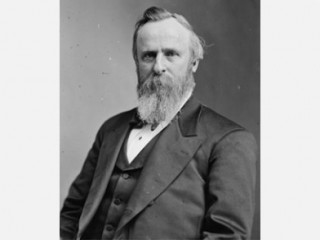
Rutherford Birchard Hayes biography
Date of birth : 1822-10-04
Date of death : 1893-01-17
Birthplace : Delaware, Ohio, U.S.
Nationality : American
Category : Politics
Last modified : 2010-10-01
Credited as : Politician, former U.S. President, Republican party
3 votes so far
Rutherford B. Hayes was born Oct. 4, 1822, in Delaware, Ohio. His family, recently moved from New England, was well-to-do. Born 2 months after his father's death, Hayes was dominated by his neurotic mother and sister and patronized by his wealthy uncle Sardis Birchard.
Birchard was a critical influence in Hayes's life and helped pay for his education. Graduating from Kenyon College with highest honors in 1842, Hayes went to Harvard Law School in 1843. In 1845 he moved to Lower Sandusky (now Fremont), Ohio, to practice law under his uncle's sponsorship. Easygoing and pliable, Hayes was inclined to accept the conservative ideals surrounding him, and he adopted his uncle's Whig politics and distaste for abolitionists. The tall, handsome Hayes was a congenial and ready conversationalist, and he enjoyed considerable popularity in the town. Nevertheless, in 1849 he moved to Cincinnati, then the most important city in the West.
The young lawyer's personability and good showing in a celebrated homicide case soon won Hayes some reputation and political notice. Like most Northern Whigs during the late 1850s, Hayes had turned to the Republican party. However, he was not excessively interested in political questions; during the momentous election of 1860 he wrote, "I cannot get up much interest in the contest." He preferred the casual society of the "best people," travel, and occasional lectures on temperance.
War Years
Hayes's life of genteel idleness ended with the Civil War. He accepted a commission as major of the 23d Ohio Infantry. Now, for the first time in his life, he truly reveled in an all-masculine world, and he later looked back on the war as "the best years of our lives." He was brave to the point of recklessness and was wounded four times, once seriously. He rose to the rank of major general. What was more significant, his war record catapulted him into prominence in Ohio politics. While he was still in the military, he was nominated by the Republicans to serve in Congress and was elected without campaigning. He went to Washington for two terms, beginning in 1864.
In 1867 Hayes was elected governor of Ohio. He compiled a "moderate" record on all issues and retired to what he regarded as a permanent private life in 1871. However, in 1875, Republican leaders prevailed on him to stand again for governor, with the possibility of the presidential nomination the next year clearly understood. Successful, he entered his third term.
Disputed Election
Hayes entered the Republican nominating convention of 1876 as a minor candidate. The favorite, James G. Blaine, faced a number of opponents. In addition, the Republicans were sensitive to charges of political corruption, as the administration of Ulysses S. Grant had been blackened by scandal and Blaine had been implicated in a stock manipulation deal. Blaine's rivals withdrew one by one in favor of the deliberately "passive" Hayes.
The election, which pitted Republican Hayes against Democrat Samuel J. Tilden, proved more difficult. Owing to questions of the legitimacy of vote casting and counting in several states, the whole election was questioned and the country plunged into debate. Finally, a congressional commission was established to decide the election. By a curious twist the commission was composed of eight Republicans and only seven Democrats. However, the dispute was settled, and Hayes took office in March 1877 without further serious incident because the Republicans had made informal agreements with Southern Democrats to work toward establishment of a new political alliance between men of means in both the North and the South. Hayes's party thus hoped to drive a wedge between the two wings of its opposition.
Hayes was more than happy with the plan. He was naturally a "Whig" and had been uncomfortable with Grant's "bloody shirt" politics. He did not personally regard deals with the Southern Democrats as abandoning the Republican commitment to Southern blacks; rather, he hoped to win paternalistic protection for them by encouraging the growth of the Republican party among whites.
As president, Hayes withdrew the last Federal troops from the South and, as a symbol of the end of this phase of the Reconstruction, decorated Confederate graves on Memorial Day, 1877. "My task was to wipe out the color line, to abolish sectionalism; to end the war and bring peace," Hayes remembered, but by 1878 he had to state, "I am reluctantly forced to admit that the experiment was a failure."
Though Hayes was as meticulous with detail as ever and dispensed his presidential duties ably, he abhorred active leadership. He pledged to serve only one term, and the Republicans were happy to retire him. Hayes spent his final years in prosperous retirement in Lower Sandusky, distracting himself with active participation in the Grand Army of the Republic and other veterans' organizations. He died on Jan. 17, 1893.
















